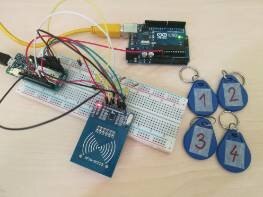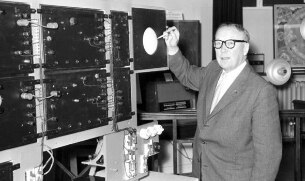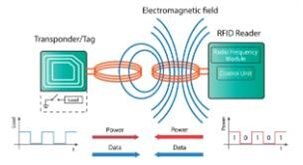 |
Enter Your Electronics & Design Project for a chance to win a $100 Shopping Cart! |
Project14 Home |
| Monthly Themes | ||
| Monthly Theme Poll |
In the comments below: Propose a Project that Uses NFC or RFID!
Bonus: We'll Send Out a Limited Number of NXP NFC SBC Kits for Project Ideas that Use Them!
 |
| We're offering a limited number of NXP NFC controller Single Board Computer (SBC) kits for project proposals! |
| Buy NowBuy Now or Buy NowBuy Now |
The theme this month is NFC/RFID and the idea comes from dougw . The idea is to build projects that use NFC or RFID for applications such as access control, asset tracking, making contactless payments, and more. Both RFID and NFC use radio waves to communicate. RFID systems have an RFID tag or smart label, an RFID reader, and an antenna. The RFID tag uses an integrated circuit and an antenna, which to transmit data to an RFID reader. Both the RFID readers and the tag must be tuned to the same frequency to communicate. NFC is a branch of High-Frequency (HF) RFID, both operate at the 13.56 MHz frequency. NFC protocol is used for secure form of data exchange, with an NFC device is capable of being both an NFC reader and an NFC tag. NXP is a co-inventor of NFC along with Sony and supplies the chip that enables your smart phone to make contactless payments, store, and exchange goods securely. As a result, we're going to send a limited number of Plug N' Play NFC controller SBC kits for project proposals that use a compatible Arduino, Beagleboard, or Raspberry Pi.
Examples of projects you could do include Arduino based RFID door locks, use an RFID tag to build a pet tracking device, embed RFID in a wristband or ring for attendance monitoring at events, an NFC payment system to allow purchases from a smart phone, an RFID device you can use to prevent theft such as in clothing or valuable items, integrate RFID with an everyday item to share information with social media, and more. Applications for RFID include theft prevention of automobiles, collecting tolls without stopping, traffic management, building access control, automated parking, dispensing goods, tracking library books, and tracking a wealth of assets in supply chain management. NFC also has many exciting applications such as smart cards, e-wallets, smart-ticketing, moderating health and medical conditions, and keyless access. You can uses an NFC enabled smart phone to tap NFC smart tags that could appear in everything from movie posters and music flyers to museum tour placards.
In the future, RFID can be used to replace barcodes so you can pick up groceries without the need to do self-checkout or wait in line
Today, RFID is used in soft drink dispensers at restaurants to automatically restock vending machines using radio waves:
Become Instant Friends on Facebook with someone you just met at the bar:
Asset Tracking to simplify the task of packing up for a Trip:
Discovery of Radio Waves on the Electromagnetic Spectrum
 |
Like everything else, you can trace back the foundation of RFID to Electromagnetism. During the Big Bang, scientists have deduced that all four of the the fundamental forces of nature - gravity, electromagnetism, and the strong and weak nuclear forces - were unified. The first form in the universe was electromagnetic energy. During the first few seconds or so of the universe, protons, neutrons and electrons began formation when photons (the quantum element of electromagnetic energy) collided converting energy into mass. The electromagnetic remnant of the Big Bang survives today as background microwave hiss. This very energy is the source of RFID. Although it would take another 14 billion years or so until humans came along, discovered how to harness electromagnetic energy in the radio region, and applied their knowledge to further the development of RFID technology.
RFID is an acronym radio-frequency identification and uses electromagnetic fields to automatically identify and track tags attached to objects. Tags contain electronically stored information. A passive tag collects energy from a nearby RFID reader's interrogating radio waves. Unlike passive tags, which do not have their own power source, an active tag includes a local power source (such as a battery) and may operate hundreds of meters from the RFID reader. RFID has been considered a replacement for barcodes, and unlike barcodes the tag does not need to be within line of sight of the reader, it can be embedded in the tracked object. RFID is one method of automatic identification and data capture (AIDC).
The most common RFID frequencies used for RFID applications are: Low frequency (9-135 KHz), High frequency (13.553-15.567 MHz), Amateur radio band (430-440 MHz), Ultra-high frequency (860-930 MHz), and Microwave (2.4-2.4835 GHz, 5.8 GHz) The frequency that you choose will depend on the type of RFID application and region specific requirements.
 |
 |
The electromagnetic field that surrounds an RFID antenna is broken up into two segments – near-field and far-field. The two segments of the RF field, near-field and far-field, have different energies so they typically require a corresponding antenna type to get the best read range. The near-field is primarily magnetic in nature, while the far-field uses both electric and magnetic components.
Communication between an RFID tag and an RFID reader (via the antenna) is one-way and occurs using a process known as electromagnetic coupling. The two types of coupling are inductive and capacitive. A near-field antenna uses inductive coupling, meaning it uses a magnetic field to energize the RFID tag. The magnetic field is created in the near-field region, allowing the RFID reader’s antenna to energize the tag. The tag then responds by creating a disturbance in the magnetic field which the reader picks up and decodes. A far-field antenna uses capacitive coupling (or propagation coupling) to energize the RFID tag. Capacitive coupling occurs when the RFID reader’s antenna propagates RF (radio-frequency) energy outward and the energy is then used to energize the tag. The tag then sends back a portion of that RF energy to the reader’s antenna as a response known as backscatter.
NFC is rooted in RFID but distinguishes itself by allowing two-way communication between electronic devices to establish communication through near-field communication (NFC) within 4 cm (1.6 in) of each other. Specifically, NFC is a branch of High-Frequency (HF) RFID They both operate at the 13.56 MHz frequency.
NFC Emerges from RFID
NFC was designed as secure form of data exchange based on RFID. What is unique about an NFC device is that it is capable of acting as both an NFC reader and an NFC tag allowing devices to communicate peer-to-peer. The ability to communicate peer-peer has made NFC a popular choice for contactless payment. Many smart phones use NFC communication to allow contactless payment. Apple Pay is simply Apple’s own “version” of NFC. Google uses their own version as well, Google Wallet. Most Android devices have included full NFC support since 2012. Apple has been more conservative in implementing the technology, waiting till 2014 with the introduction of Apple Pay to the iPhone 6 and 6+ models. However they kept the functionality locked to Apple Pay and removed all mention of NFC from their tech-specs. In 2017, iOS 11 allowed iPhone 7 and newer devices to read NFC through a 3rd party app and a year later Apple opened up NFC tag reading from the home screen with the introduction of the iPhone XS, XS Max and XR. Nevertheless, Apple has a ways to go before they fully support everything NFC has to offer. For instance, the read / write mode is currently locked to read-only, making it impossible to write to an NFC tag with an iPhone. Also, Apple has yet to implement file sharing with NFC's peer-to-peer mode, instead focusing on wireless file sharing through their proprietary AirDrop.
Fully enabled NFC smartphones use the technology to pass information from one smartphone to the other by tapping the two devices together, allowing you to share data such as contact info or photographs. Another use of NFC can be seen in advertising campaigns that use smart posters to pass information to consumers. NFC devices can read passive NFC tags, and some NFC devices are able to read passive HF RFID tags that are compliant with ISO 15693. The data on these tags can contain commands for the device such as opening a specific mobile application. In essence, NFC builds upon the standards of HF RFID and turns the limitations of its operating frequency into a unique feature of near-field communication.
Franz Amtmann and Philipe Maugers of NXP coinvented NFC with Sony in 2002:
RFID Through the Years
NFC is a relatively new technology, compared to RFID which has actually been around for a long time. During the Electromagnetism competition, we talked about what a game changer Maxwell's Equations were, and the proof of their validity, led to the discovery of radio waves, and RFID technology followed as a result. The Maxwell Equations, together with the Lorentz force law, form the foundation of classical electromagnetism, classical optics, and electric circuits. James Clerk Maxwell's mathematical theory of 1873 had predicted that electromagnetic disturbances should propagate through space at the speed of light and should exhibit the wave-like characteristics of light propagation. He did not live long enough to witness the physical manifestations of many of his mathematical proofs. Before he passed away, James Clerk Maxwell predicted that there should be light with even longer wavelengths than infrared light. In 1887 Heinrich Hertz demonstrated the existence of such waves by producing radio waves in his laboratory. Years later, a German engineer named Chistian Huelsmeyer proposed a detecting device that used radio echoes to avoid collisions in marine navigation.
 |
 |
In 1935, Sir Robert Watson-Watt wrote and presented "The Detection of Aircraft by Radio Methods" to the chairman of the Committee for the Scientific Survey of Air Defense. His idea was to bounce a radio wave against an object and measure the distance of its travel to provide targeting information. This was known as radio detection and imaging, better known by the acronym radar. Radar was used by both sides during World War 2, in order to identify aircraft. Unfortunately, it could not identify whether a plane was a friendly or a foe. The Germans noticed that if they rolled their planes as they returned to base it would change the radio signal reflected back to create a uniquely identifiable system, a sort of first passive RFID. Sir Watson-Watt would head a secret project by the British to develop a less crude system of uniquely identifying aircraft. The identify Friend or Foe (iff) system that he helped develop would become the first active RFID. A transmitter was placed in British planes. It would be used to receive radio signals from radar stations on the ground and when it did, it would broadcast a signal back to let you know it was a friendly. The basis of RFID technology is a combination of radio signals and radar.
In 1948, Harry Stockman published “Communications by Means of Reflected Power” in the Proceedings of the IRE. This landmark paper is considered by some to be the birth of RFID. However, for RFID to be what it is nowadays, it would take some 30 years for technology to catch up with the theory, particularly the advent integrated circuit, the microprocessor, and a changing business landscape . On January 23, 1973, Mario W. Cardullo claimed the first U.S. patent for an active RFID tag with rewritable memory. Later that year, Charles Watson received a patent to use a passive transponder to unlock a door without a key. A transponder would be embedded in a card and communicate a signal to a reader near the door. When the reader detected a valid identity number stored within the RFID tag, the reader unlocked the door. Walton licensed the technology to various lock makers.
In the 70s, The US Energy Department for the U.S. asked Los Alamos National Laboratory to use RFID to track nuclear material. A transponder was put in trucks and readers were used at the gates of secure facilities. The gate antenna would wake the transponder in the truck, which would then respond with an ID and potentially other data, such as the driver's ID. The system would become the basis of the automated toll system in the mid-1980s when a group of Los Alamos scientists left to commercialize the project. RFID systems would now become widely used on roads, bridges and tunnels throughout the world. At the behest of the US Agricultural Department, Los Alamos also developed a passive RFID tag to track cows. This was used to make sure that cows received the right dosage of hormones and medicines when they were ill. Their passive RFID system used UHF radio waves. A device drew energy from the reader and reflected back a modulated signal to the reader using a backscatter technique. Later, companies were able to come up with a low-frequency (125 kHz) system that featured smaller transponders. Each transponder was encapsulated in glass and could be injected under the cows skin. This is the system is still used on cows around the world today. Low-frequency transponders were also put in cards for control access to buildings.
125 kHz systems continued being commercialized and then moved up the radio spectrum to high frequency (13.56 MHz), unregulated and unused in most parts of the world. The advantage of using high frequency was that it offered greater range and faster data transfer rates. RFID, especially in Europe Companies, began being used to track reusable containers and other assets. Today, high frequency RFID at 13.56 MHz is used for access control, payment systems such as mobile speedpasses and contactless smart cards. It's also used as an anti-theft device in cars. The reader is placed in the steering column and reads a passive RFID tag in the key. If the ID number is not a match the car won't start. 
In the early 90s, engineers at IBM developed and patented an ultra-high frequency (UHF) RFID system. UHF offered even greater range (up to 20 feet under good conditions) along with a faster data transfer. IBM failed in its attempts to commercialize the technology, Walmart was an early pilot, and later sold the patents to Intermec when they ran into financial trouble in the mid 90s. Intermec RFID systems can be found in numerous applications such as warehouse tracking and farming. Lack of standards were the main drawback to large scale standardization. This began to change as use became widespread and standards began to emerge. In 1999, a number of organisations set up the Auto-ID Center at the Massachusetts Institute of Technology to enable common standards to be set up. The International Standards Organization, ISO, introduced standards for different elements of RFID such as in readers and writers. In 2005, Walmart further mainstreamed the technology by requiring its top 100 suppliers to apply RFID labels to all shipments. Another milestone in RFID history occurred when suppliers started to take RFID seriously and in January 2005, Wal-Mart required its top 100 suppliers to apply RFID labels to all shipments.
Throughout the 90s RFID use became widespread, by companies and consumers, and standards began to emerge. In the 2000s, improved technology led to miniaturization, the cost of RFID continued to fall, and private authentication developed as a key concern in library implementation.
Your Monthly Theme
| The Monthly Theme You Voted For: NFC / RFID | |
|---|---|
| Safe & Sound -Flood early-warning Alarm Pack #5: Test of TRF7970A NFC BoosterPack-DLP Designed | The Light up NFC Bracelet: Stage 3 |
|
|
|
Your Chance to Win
| Be Original |
Stick to the Theme |
|---|---|
|
|
| List the Steps |
Submit Video Proof |
|
|
Your Project Examples
| NFC / RFID |
|
|---|---|
| Safe&Sound: Wearable Tracking Device for Miners - 14: RC522- reading RFID tags | Fingerprint Skeleton Key - RFID Module - Design for a Cause Challenge - Blog Post #3 |
|
|
|
Your Prizes
| 3 First Place Winners: Win a $100 Shopping Cart |
||
|---|---|---|
|
||
 |
 |
|
Your Project, Your Ideas!
| About Project14 |
Directions |
|---|---|
|
Every month you'll have a new poll where you'll get to decide an upcoming project competition, based on your interests, that will take place a couple of months in advance. Themes are broad in scope so that everyone can participate regardless of skill set.
What are Monthly Themes?
What are Monthly Theme Polls?
|
Step 1: Log in or register on element14, it's easy and free. Step 2: Post in the comments section below to begin a discussion on your idea. Videos, pictures and text are all welcomed forms of submission. Step 3: Submit a blog post of your progress on your project by the end of the month. You are free to submit as many blog entries as you like until the beginning of the next theme.
Be sure to include video proof of your project!
Visit: NFC/RFID or tag your project blog nfcrfidch
You have until June 14th End of Day to submit your completed project!
A jury consisting of your peers will judge project submissions! |
In the comments below: Let Us Know Your Project Ideas for Communicating Wirelessly Using NFC or RFID!








Top Comments
-

sureshluhana
-
Cancel
-
Vote Up
+1
Vote Down
-
-
Sign in to reply
-
More
-
Cancel
-

Fred27
in reply to sureshluhana
-
Cancel
-
Vote Up
+1
Vote Down
-
-
Sign in to reply
-
More
-
Cancel
Comment-

Fred27
in reply to sureshluhana
-
Cancel
-
Vote Up
+1
Vote Down
-
-
Sign in to reply
-
More
-
Cancel
Children